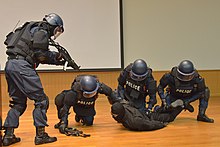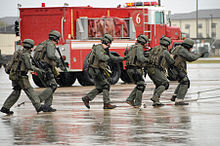Police tactical unit

A police tactical unit (PTU)[a] is a specialized police unit trained and equipped to handle situations that are beyond the capabilities of ordinary law enforcement units because of the level of violence (or risk of violence) involved.[2][3][4] The tasks of a police tactical unit may include executing dangerous search warrants and arrest warrants for dangerous persons; arresting or neutralizing dangerous or mentally ill armed persons; and intervening in high-risk situations such as shootouts, standoffs, hostage-takings, and terrorist incidents.[5][6]
Definition
[edit]
Police tactical units are dedicated units composed of personnel selected and trained in tactical skillsets to carry out the responsibilities of the unit, and in use-of-force policies, including lethal force for counterterrorism.[8] A PTU is equipped with specialized police and military-type equipment.[9] A PTU may have specialized combat assault dogs with personnel trained as dog handlers.[10] PTU personnel may also be trained in crisis negotiation.[11]
A police tactical unit can be part of either a police force under the authority of civilian officials,[12] or a gendarmerie-style force under the authority of civilian officials (interior ministry) or a defence ministry that may have formal military status.[13][12] Other government agencies, depending on the country, may establish specialized units with comparable taskings, training, and equipment, such as border guard, coast guard, customs, or corrections.[14]
In the United States, police tactical units are known by the generic term SWAT (special weapons and tactics) team;[15][16] the term originated from the Philadelphia Police Department and the Los Angeles Police Department in the 1960s.[17][15][18] In Australia, the federal government uses the term police tactical group.[3] The European Union uses the term special intervention unit for national counterterrorist PTUs.[19]
Characteristics
[edit]
Police tactical units have similarities to military special forces units such as organization, selection, training, equipment, and operational methodologies.[20][21] Police tactical units, similar to military units, are not gender diverse, with female members being rare.[22][23]
For "certain counter terrorism operations, such as hostage rescue, there is a significant convergence of roles, tactics and force when employed in either an armed conflict or policing role".[24] Aside from counterterrorism, the roles of police and military units differ in that the role of military units can result in the use of the maximum permissible force against enemy combatants while the role of police units is to use only minimal force sufficient to subdue suspected criminals, including negotiation.[25][26][27]
See also
[edit]Notes
[edit]- ^ Some academic literature from North America uses the term "police paramilitary unit" (PPU) to describe police tactical units.[1]
References
[edit]- ^ Alvaro 2000, p. 3.
- ^ Alvaro, Sam (2000). Tactical law enforcement in Canada; an exploratory survey of Canadian police agencies (Thesis). Carleton University. p. 1,37,51-52. ISBN 9780612484191. Retrieved 29 August 2021.
- ^ a b Australia-New Zealand Counter-Terrorism Committee (2017). Active Armed Offender Guidelines for Crowded Places (PDF). Commonwealth of Australia. p. 3. ISBN 9781925593976. Retrieved 30 September 2017.
- ^ Rantatalo, Oscar (2013). Sensemaking and organising in the policing of high risk situations: focusing the Swedish Police National Counter-Terrorist Unit (PDF) (Thesis). Umeå: Department of Education, Umeå University. p. 15,32. ISBN 9789174596991. Retrieved 25 May 2017.
- ^ Alvaro 2000, p. 99-103.
- ^ NTOA 2018, p. 10.
- ^ Alvaro 2000, p. 39-40.
- ^ NTOA (April 2018). "Tactical Response and Operations Standard for Law Enforcement Agencies" (PDF). p. 12,34,38. Retrieved 3 February 2021.
- ^ NTOA 2018, p. 45.
- ^ Neville, Leigh (2017). European Counter-Terrorist Units 1972-2017. Elite 220. Illustrated by Adam Hook. Oxford: Osprey Publishing. p. 13. ISBN 9781472825278.
- ^ NTOA 2018, p. 35.
- ^ a b Alvaro 2000, p. 40.
- ^ Lutterbeck, Derek (2013). The Paradox of Gendarmeries : Between Expansion, Demilitarization and Dissolution (PDF). SSR PAPER 8. Geneva: Geneva Centre for the Democratic Control of Armed Forces (DCAF). p. 7. ISBN 9789292222864. Retrieved 3 February 2021.
- ^ Alvaro 2000, p. 44.
- ^ a b Rantatalo 2013, p. 15.
- ^ Alvaro 2000, p. 72.
- ^ Mitchel P. Roth & James Stuart Olson, Historical Dictionary of Law Enforcement, Westport, Ct: Greenwood Publishing Group, 2001, p. 333 and; John S. Dempsey & Linda S. Forst, An Introduction to Policing, Clifton Park, NY: Delmar Cengage Learning, 2011, p. 276.
- ^ Alvaro 2000, p. 27-28.
- ^ On the improvement of cooperation between the special intervention units of the Member States of the European Union in crisis situations (Council Decision 2008/617/JHA). 23 June 2008. Retrieved 26 May 2017.
- ^ North Atlantic Treaty Organization (18 December 2020). NATO Glossary of Terms and Definitions (PDF) (in English and French). Vol. AAP-06 (2020 ed.). Brussels: NATO Standardization Agency. p. 119. Archived from the original (PDF) on 2 June 2021.
- ^ Alexander, John B (July 2010). "4: Comparison between SOF and Law Enforcement Agencies". Convergence: Special Operations Forces and Civilian Law Enforcement (Report). JSOU report 10-6. MacDill Air Force Base, Florida: Joint Special Operations University (JSOU) Press. pp. 48–62. Retrieved 29 August 2021.
- ^ Dahle, Thorvald O. (March 2015). "Women and SWAT: Making Entry into Police Tactical Teams" (PDF). Law Enforcement Executive Forum. 15 (1). Macomb, Illinois: Illinois Law Enforcement Training and Standards Board Executive Institute: 21,25. doi:10.19151/LEEF.2015.1501b (inactive 19 January 2025). ISSN 1552-9908. Archived from the original (PDF) on 6 October 2017.
{{cite journal}}: CS1 maint: DOI inactive as of January 2025 (link) - ^ Turnley, Jessica Glicken; Stewart, Dona J.; Rubright, Rich; Quirin, Jason (June 2014). Special Operations Forces Mixed-Gender Elite Teams (PDF). William Knarr (Project Leader). MacDill Air Force Base, Florida: Joint Special Operations University (JSOU) Press. pp. 11, 85–86. Retrieved 3 February 2021.
- ^ Watkin, Kenneth (2016). Fighting at the Legal Boundaries: Controlling the Use of Force in Contemporary Conflict. New York: Oxford University Press. p. 437. ISBN 9780190457976.
- ^ Newburn, Tim; Neyroud, Peter (2013). Dictionary of Policing. Abingdon, Oxon: Routledge. p. 187. ISBN 9781843922872.
- ^ Weber, Diane Cecilia (1999). Warrior Cops: The Ominous Growth of Paramilitarism in American Police Departments (PDF). Cato Briefing Papers No. 50. Washington: Cato Institute. p. 3. Retrieved 25 May 2017.
- ^ Rantatalo 2013, p. 23.
Further reading
[edit]- Katz, Samuel M. (1995). The Illustrated Guide to the World's Top Counter-Terrorist Forces. Hong Kong: Concord Publication Company. ISBN 9623616023.
- Lippay, Christopher (2021). The ATLAS Network : European Special Intervention Units combating terrorism and violent crime (English ed.). Stumpf + Kossendey, Edewecht. ISBN 9783964610447.
- Metzner, Frank; Friedrich, Joachim (2002). Polizei-Sondereinheiten Europas Geschichte - Aufgaben - Einsätze [Police-Special units of Europe History-Tasks-Operations] (in German). Stuttgart: Motorbuch Verlag. ISBN 9783613022492.
External links
[edit] Media related to Police tactical units at Wikimedia Commons
Media related to Police tactical units at Wikimedia Commons
